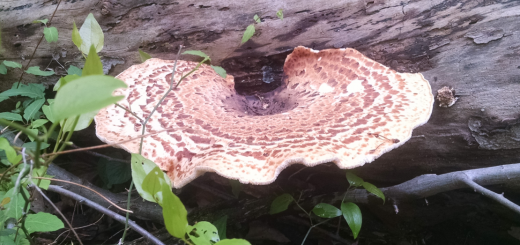#023: Tremella fuciformis, the Snow Fungus
This beautiful jelly mushroom also goes by a variety of other common names, including: silver ear fungus, white ear fungus, and white jelly fungus. The fungus fruits from decaying wood and produces white, translucent mushrooms that have a gelatinous consistency. Its name seems to come from its white color and roughly snowball-shaped fruiting bodies. Although, if you ask me, its name was probably also inspired by its “graceful lobes,”* which look somewhat like large, squishy points on a snowflake. The snow fungus’s range is tropical to subtropical, but it can apparently be found in the United States at least as far north as Indiana. Despite its name, you will not find this mushroom poking out of snow-covered branches. The mushroom prefers to fruit in the summer and fall, so if you want to see this fungus for yourself you’ll either have to wait half a year or visit the mushroom section of an Asian market.
That’s right, T. fuciformis is edible! In fact, it is considered a delicacy in China and Japan. The snow fungus is also believed to have medicinal properties (some of which have been backed up by scientific studies). The mushrooms are sold in their dried-out form but they easily rehydrate when placed in water for 5 to 10 minutes. So what does the snow fungus taste like? Not much. The real culinary appeal of this mushroom is its texture. Apparently the mushrooms are pleasantly rubbery and slightly crispy. This interesting texture can be used to liven up a number of dishes, though it seems to be most commonly used in soups and desserts.
For a long time this mushroom was only available to the wealthy classes, due to the wild mushroom’s relatively small size and rarity. Despite the fact that T. fuciformis is found growing on wood, it resisted attempts at cultivation. Eventually, studies of the Tremella genus revealed that these fungi are parasitic on other fungi. In the case of T. fuciformis, it is a symbiont with Hypoxylon archeri. If you find the snow fungus in the wild, you will likely see small, black bumps on the adjacent wood. These black bumps are the fruiting bodies of H. archeri. The exact type of symbiotic interaction is unclear: T. fuciformis may be a parasite or it may need H. archeri to break down the wood into usable compounds. Once the snow fungus’s ecology was figured out, it could be easily cultivated by first inoculating the substrate with H. archeri. Another factor that probably hindered early attempts at cultivation is that T. fuciformis will grow as a yeast in the absence of its desired substrate (see FFF#003 for more on yeast/hyphal growth modes). These cultures would probably have been presumed to be contaminated and subsequently thrown out.








![#011: Characteristics of Kingdom Fungi [Archived]](https://www.fungusfactfriday.com/wp-content/themes/hueman/assets/front/img/thumb-small-empty.png)

2 Responses
[…] decide if the flavorless fungus is worth eating. Like the Snow Fungus (Tremella fuciformis, see FFF#023), Witch’s Butter would be eaten for its texture rather than its […]
[…] it. Like the Jelly Ear (Auricularia auricula, FFF#134) and the Snow Fungus (Tremella fuciformis, FFF#023), Witch’s Butter would be eaten for its texture and not its […]